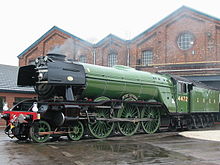This article needs additional citations for verification. (November 2021) |


A steam locomotive is a locomotive that provides the force to move itself and other vehicles by means of the expansion of steam.[1]: 80 It is fuelled by burning combustible material (usually coal, oil or, rarely, wood) to heat water in the locomotive's boiler to the point where it becomes gaseous and its volume increases 1,700 times. Functionally, it is a steam engine on wheels.[2]
In most locomotives, the steam is admitted alternately to each end of its cylinders in which pistons are mechanically connected to the locomotive's main wheels. Fuel and water supplies are usually carried with the locomotive, either on the locomotive itself or in a tender coupled to it. Variations in this general design include electrically powered boilers, turbines in place of pistons, and using steam generated externally.
Steam locomotives were first developed in the United Kingdom during the early 19th century and used for railway transport until the middle of the 20th century. Richard Trevithick built the first steam locomotive known to have hauled a load over a distance at Pen-y-darren in 1804, although he produced an earlier locomotive for trial at Coalbrookdale in 1802.[3] Salamanca, built in 1812 by Matthew Murray for the Middleton Railway, was the first commercially successful steam locomotive.[4] Locomotion No. 1, built by George Stephenson and his son Robert's company Robert Stephenson and Company, was the first steam locomotive to haul passengers on a public railway, the Stockton and Darlington Railway, in 1825. Rapid development ensued; in 1830 George Stephenson opened the first public inter-city railway, the Liverpool and Manchester Railway, after the success of Rocket at the 1829 Rainhill Trials had proved that steam locomotives could perform such duties. Robert Stephenson and Company was the pre-eminent builder of steam locomotives in the first decades of steam for railways in the United Kingdom, the United States, and much of Europe.[5]
Towards the end of the steam era, a longstanding British emphasis on speed culminated in a record, still unbroken, of 126 miles per hour (203 kilometres per hour) by LNER Class A4 4468 Mallard,[6] however there are long-standing claims that the Pennsylvania Railroad class S1 achieved speeds upwards of 150 mph, though this was never officially proven.[7][8][9][10] In the United States, larger loading gauges allowed the development of very large, heavy locomotives such as the Union Pacific Big Boy, which weighs 540 long tons (550 t; 600 short tons) and has a tractive effort of 135,375 pounds-force (602,180 newtons).[11][note 1]
Beginning in the early 1900s, steam locomotives were gradually superseded by electric and diesel locomotives, with railways fully converting to electric and diesel power beginning in the late 1930s. The majority of steam locomotives were retired from regular service by the 1980s, although several continue to run on tourist and heritage lines.[12]
- ^ Fowler, George Little (1906). Locomotive dictionary; an illustrated vocabulary of terms which designate American Railroad locomotives, their parts, attachments and details of construction, with definitions and illustrations of typical British locomotive practice; five thousand one hundred and forty-eight illustrations. New York: Railroad Gazette. ISBN 978-0-912318-20-2.
- ^ "Railways". British History Online.
- ^ Anthony Burton (2000). Richard Trevithick; Giant of Steam. Aurum Press. pp. 85–94. ISBN 1-85410-878-6.
- ^ Hamilton Ellis (1968). The Pictorial Encyclopedia of Railways. Hamlyn Publishing Group. p. 20.
- ^ Ellis, Hamilton (1968). The Pictorial Encyclopedia of Railways. pp. 24–30. Hamlyn Publishing Group.
- ^ "Magnificent Mallard: World's fastest steam locomotive". BBC News. 17 February 2018.
- ^ Reed, Brian (1972). Loco Profile 24: Pennsylvania Duplexii. Profile Publications Ltd.
- ^ Pennypacker, Bert (1962). Pennsy Power: Steam and Electric Locomotives of the Pennsylvania Railroad, 1900-1957. Alvin Staufer.
- ^ "High-Capacity Locomotive for Fast Service" Railway Age Vol. 106, No. 25. Simmons-Boardman Publishing Corporation. 24 June 1939.
- ^ M. Grant, Roderick (December 1941). "Riding the Gargantua of the Rails". Popular Mechanics.
- ^ Kratville, William (1972). Big Boy. Kratville Publications.
- ^ "Blenkinsop, John". Oxford Dictionary of National Biography (online ed.). Oxford University Press. doi:10.1093/ref:odnb/2637. (Subscription or UK public library membership required.)
Cite error: There are <ref group=note> tags on this page, but the references will not show without a {{reflist|group=note}} template (see the help page).